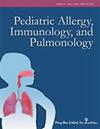吸入干粉甘露醇治疗儿童囊性纤维化患者:在现实世界环境下的临床数据评估。
IF 0.8
4区 医学
Q4 ALLERGY
引用次数: 1
摘要
背景:囊性纤维化(CF)是一种遗传性疾病,气道分泌物清除缺陷导致进行性肺功能丧失。吸入甘露醇用于增加痰液和纤毛粘膜清除率。关于甘露醇对儿童的有效性的实际研究数据很少。我们的目的是评估小儿患者使用甘露醇的肺活量测定和临床结果。方法:回顾性分析30例已接受重组人脱氧核糖核酸酶(rhDNase)治疗的儿童和青少年CF患者吸入甘露醇的记录。2-4个月时1秒用力呼气量(FEV1)较基线的变化是主要终点。次要指标是其他肺活量测定结果、体重指数(BMI)、住院情况、痰特征和阳性细菌定植。结果:与基线相比,我们发现治疗2-4个月时预测FEV1百分比显著改善;84.50(58.00 - -99.00)和96.00 (66.00 - -106.00)(P = 0.0007)。FEV1的绝对变化在2-4个月为+11.5%,在5-7个月为+6.5%,在8-12个月为+4%。此外,其他肺活量测定结果也有显著改善。青少年的FEV1结果明显较低,但他们肺功能的改善持续的时间比儿童长。甘露醇使痰更容易清除,痰量增加,住院率显著降低,痰培养阳性患者显著减少。在8-12个月时观察到BMI显著增加。咳嗽是最常见的不良反应。结论:在现实环境中,我们的研究结果表明,在小儿CF患者的rhDNase治疗中添加甘露醇是可以耐受的,并且可以改善肺活量测定和临床结果。此外,我们的研究结果显示,甘露醇在2-4个月时提供了整体肺功能的恢复,这种恢复持续了12个月,同时改善了BMI,更容易清除痰,细菌定植和住院率下降。然而,咳嗽是最常见的副作用。本文章由计算机程序翻译,如有差异,请以英文原文为准。
Inhaled Dry Powder Mannitol Treatment in Pediatric Patients with Cystic Fibrosis: Evaluation of Clinical Data in a Real-World Setting.
Background: Cystic fibrosis (CF) is a genetic disorder, in which defective clearance of airway secretions leads to progressive lung function loss. Inhaled mannitol is used to increase sputum and mucociliary clearance. There are little data from real-world studies on the effectiveness of mannitol in children. Our objective was to evaluate the spirometry and clinical results of mannitol in pediatric patients. Methods: We retrospectively reviewed the records of 30 children and adolescents with CF receiving inhaled mannitol who were already on recombinant human deoxyribonuclease (rhDNase) treatment. The change in forced expiratory volume in 1 second (FEV1) from baseline at 2-4 months was the primary outcome. Secondary measures were other spirometry results, body mass index (BMI), hospital admissions, sputum characteristics, and positive bacterial colonization. Results: Compared to baseline, we found significant improvement in percent predicted FEV1 at 2-4 months of treatment; 84.50 (58.00-99.00) vs. 96.00 (66.00-106.00) (P = 0.0007). The absolute change in FEV1 was +11.5% at 2-4 months, +6.5% at 5-7 months, and +4% at 8-12 months. Also, significant improvements in other spirometry results were observed. Adolescents had significantly lower FEV1 results, but the improvement in their lung function was sustained for a more extended period than children. Mannitol provided easier sputum removal, increased sputum volume, significant decline in hospitalizations, and significantly fewer patients with positive sputum cultures. A significant increase in BMI at 8-12 months was observed. Cough was the most frequent adverse effect. Conclusion: In a real-world setting, our results demonstrated that adding mannitol to rhDNase therapy is tolerable in pediatric patients with CF and may provide improved spirometry and clinical outcomes. In addition, our results showed that mannitol provided recovery in overall lung function at 2-4 months, which was sustained up to 12 months together with improved BMI, easier sputum removal, and a decline in bacterial colonization and hospital admissions. However, cough was the most frequent side effect.
求助全文
通过发布文献求助,成功后即可免费获取论文全文。
去求助
来源期刊

Pediatric Allergy Immunology and Pulmonology
ALLERGY-IMMUNOLOGY
CiteScore
2.00
自引率
0.00%
发文量
23
审稿时长
>12 weeks
期刊介绍:
Pediatric Allergy, Immunology, and Pulmonology is a peer-reviewed journal designed to promote understanding and advance the treatment of respiratory, allergic, and immunologic diseases in children. The Journal delivers original translational, clinical, and epidemiologic research on the most common chronic illnesses of children—asthma and allergies—as well as many less common and rare diseases. It emphasizes the developmental implications of the morphological, physiological, pharmacological, and sociological components of these problems, as well as the impact of disease processes on families.
Pediatric Allergy, Immunology, and Pulmonology coverage includes:
-Functional and genetic immune deficiencies-
Interstitial lung diseases-
Both common and rare respiratory, allergic, and immunologic diseases-
Patient care-
Patient education research-
Public health policy-
International health studies
 求助内容:
求助内容: 应助结果提醒方式:
应助结果提醒方式:


